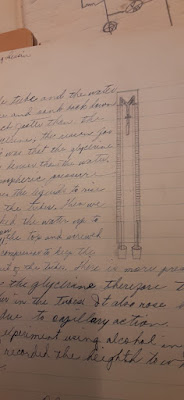7. A Loessin Leaves Family Compound
for Williamson County
8. "Uncle Mike's" Three Sons:
Edgar, Walter (Babe),
& my grandfather - Oscar (Sug)
9. "Sug's" Education - THS, another THS,
& Texas A&M
10. The Loessin Cotton Gin in Circleville
- Abstract of Title Provides
Fascinating History of Property
- Loessin Gin (1925-1975)
11. Disastrous Floods, "That Damned River Be Dammed"
Conflicting Paths, and Sug's Death
New Directions Puts Loss Behind
12. Strong-Willed Lib
13. Les & Rubie Adapt to Change
14. New Generations
_______________
A Loessin Arrives In Williamson County
 |
| My great-grandparents: Oscar Waldimar Loessin Sr. aka "Uncle Mike" and his wife Martha (Templin) at their home in Thrall, TX. |
.jpg) |
| Their three sons: Walter Lee Louis (Babe), Edgar Hermann August, and my grandfather Oscar Elmer Max (Sug) |
 |
| Interesting that my grandfather's birth certificate notes his parent's residence in Thrall yet beside great-grandfather's typed name in a signature line the birth residence is Rt. 2, Granger Texas?! |
My dad provided the most sensible explanation for these confusing address entries on this document. It was not uncommon for parents who had a child born at home to only make the journey to the county office some years later in order to make application for an official birth certificate. A pragmatic hesitation in an age when infant mortality rates were so high. Thus, grandpa was born in Thrall and would attend Thrall schools. Likely not until an official birth certificate was necessary for him did grandpa apply for a birth certificate and by this time they had moved to Circleville (which, lacking its own post office, the mailing address was Rt. 2 Granger).
 |
| My granda 'Sug' in his bedroom of the family's Thrall home, his Thrall school banner can be seen on the wall behind him. |
The parcel of land the Stearn's Gin set upon and that my great-grandfather would purchase turned out to have a fascinating lineage.
It traces the property's century of ownership back to the William Ashworth survey of 1842.
- ...a free Black Colonist and landowner, born in South Carolina about 1793...In 1831 he moved from what is now Calcasieu Parish, Louisiana, to Lorenzo de Zavala's colony in East Texas. East Texas would remain his home base for the rest of his long life while he traveled and surveyed throughout Texas, often into lands teeming with unfriendly natives and Mexicans... William and his brother Aaron Ashworth obtained an order of survey from early Land Commissioner George Antonio Nixon...
[https://www.tshaonline.org/handbook/entries/ashworth-william] - ...a black man of considerable means thanks to the great number of horses and supplies he provided the Texas Army during the war with Mexico's Santa Anna. Ashworth was rewarded by Sam Houston a First Class Headright in 1838, receiving 4605.5 acres. He obtained special legislative permission to have a Headright since laws at the time excluded African Americans from obtaining land grants.
- In February 5, 1840, Texas had made it unlawful for “any free person of color to emigrate to this Republic” and required all free blacks then residing within the Republic to leave within two years, or risk being captured and sold into slavery. Ten months later (with some influence provided by the state's new General Land Office) on December 12, 1840, the Ashworth Act was drafted in response. [https://www.tshaonline.org/handbook/entries/ashworth-act]
[https://medium.com/save-texas-history/the-ashworth-act-an-act-for-the-relief-of-certain-free-persons-of-col or-e7f92a782acd]
 |
| Ashworth profile flyer courtesy of TSHA. |
 |
| My great-uncle Walter "Babe" Loessin holding yet another big catch pulled out of the Gabriel. |
But what was particularly unique about Babe's store he ran was the place was also an ice house. Babe bought the ice from an ice plant and stored it in the cave located there along the limestone bank of the river I showed you when you were young. He'd sell it by the block or chip it for the customers."
[Sidenote about Uncle Babe: I have fond memories of Mom and Dad taking me to Thrall to visit with Uncle Babe and his wife Goldie. Babe had inherited the home in Thrall where he and his two brothers grew up (the one pictured at the top of this page where my great-grandparents are seated on the front porch). The house was small and I recall even as a child sitting quietly in the corner studying the low ceilings and tiny rooms and wondering how my great-grandparents and their three sons had moved around in it. Babe and Goldie never had any children of their own. And a final memory, it was thanks to Uncle Babe that my Mom discovered my love of hot and spicy foods. Babe made the best chili and chicken soup, loaded with pepper. Mom would often politely decline while I was beggin' for more...and I haven't let go of the pepper shaker yet!]
Did you know the Loessin Gin was first built in 1879 by an early Circleville pioneer?
Did you know it was originally powered by man and mule?
And then became the first steam powered Cotton Gin in Texas?
 |
| History of Loessin Gin provided in this news article, 1956. |
 |
| My grandmother Elizabeth "Lib" sits on my Dad "Les" Harley motorcycle, 1958. The Loessin Gin bale platform behind her. |
 |
| Switchboard similar to the one my grandfather and great-grandfather sat at when in their role as the Circleville "operator" |
Eventually, with her step-sisters listening in, grandma "Lib" consented to a date with "Sug." Pictured below are the two of them dressed up and about to take an evening drive out to the "haunted" Hoxie bridge. What a date!
 |
| Above: Grandma "Lib" posing in the lovely white cotton dress she chose for her first date with "Sug." Below: "Sug" posing in front of the Loessin home in Circleville. |
 |
Grandpa’s Selective Service document, |
 |
| Oscar Waldimar Loessin Sr. and his wife Martha (Templin) Loessin are buried in the Taylor City Cemetery. |
 |
| My grandfather Oscar E. "Sug" Loessin sits in the family home built 1925 at NW corner of the Gin property, home was relocated in 1962 .5 mile north to my parent's new property. |
After my grandfather "Sug" passed away in 1969 when I was 6 years old,
Sug's Death, and a River Be Dammed
A New Direction Puts Loss Behind
6. Strong-Willed Lib
7. Les & Rubie Adapt to Change
8. New Generations
 |
| My dad, Leslie Loessin. |
 |
| My dad, Leslie, with his grandma Martha Templin Loessin |
 |
| My dad, Leslie Loessin, dressed up as his idol Gene Autry. |
Sug's Death, and a River Be Dammed
A New Direction Puts Loss Behind
6. Strong-Willed Lib
Her mother-in-law Martha had tried to forbid it, "Whores alone bathe strange men who ain't their lawful husband. No daughter-in-law of mine is gonna be doing that!" Grandma Lib recalled it was the morning after that statement that she finally had the courage to pick up the phone with Sug in the room and made the appointment to sign up for nursing school.
When asked what experience as a nurse had the greatest affect on her she said "That's easy to answer. Finding out Sug had terminal cancer and having to play the roles of both wife and nurse at home..."
 |
| Great-Grandma Helen Quebe Lib's Mom. |
 |
| Sug on the right with Lib's two brothers to his left Joe & Richard Quebe |
 |
| Grandma Lib's second husband her former childhood sweetheart from Circleville school days Alfred Vitek |
8. New Generations
Enjoy looking through my Library:
- | HOME and FAMILY
- MATERNAL FAMILY
- PATERNAL FAMILY
- Mom & Dad
- 2023 Spring Patio Pics
- 2023 Ice Storm
- Home Remodel Projects
- Favorite Recipes
- Pets
- 2022 Holidays
- 2022 Family Reunions
- 2022 Estate Sale & Tornado!
- | NEWS and UPDATES
- | TRAVEL and DAYTRIPS
- | READING and WRITING
- | FAITH and SPIRITUALITY
- | LISTENING and VIEWING
- | EDUCATION and CAREER
______________________________Terry’s “Good Living” Guide:
Body:
Avoid the 3 PsBsSs
Processed Foods, Phthalates, Plastics;
Beef, Butter, Breads;Sedentary activities, Sugars, Salt.
Trust me,
you’ll be feeling better in no time!Mind & Spirit:
Avoid the 3 F’sManufactured in these mediums are
misinformation, fear, anger and hate!
- | HOME and FAMILY
- MATERNAL FAMILY
- PATERNAL FAMILY
- Mom & Dad
- 2023 Spring Patio Pics
- 2023 Ice Storm
- Home Remodel Projects
- Favorite Recipes
- Pets
- 2022 Holidays
- 2022 Family Reunions
- 2022 Estate Sale & Tornado!
- | NEWS and UPDATES
- | TRAVEL and DAYTRIPS
- | READING and WRITING
- | FAITH and SPIRITUALITY
- | LISTENING and VIEWING
- | EDUCATION and CAREER
Terry’s “Good Living” Guide:
Avoid the 3 PsBsSs
Processed Foods, Phthalates, Plastics;
Beef, Butter, Breads;
you’ll be feeling better in no time!
Avoid the 3 F’s
misinformation, fear, anger and hate!


















































No comments:
Post a Comment